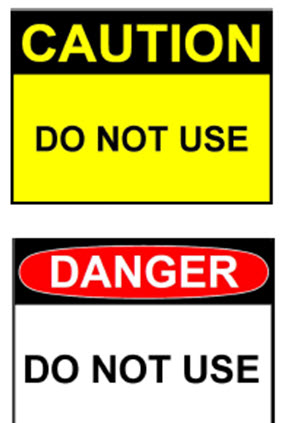Lockout Tagout is for Everyone – You must clearly mark broken items
Properly ‘locking or tagging out’ any type of equipment, chair, table, or restricting access to a damaged part of the parking lot can help to prevent injury to employees and customers. In many cases, manager’s efforts to stop employees or customers from using a piece of equipment are not adequate. For example, placing a sign on a damaged chair that says, “Do not Sit” may appear adequate, but the sign can be removed or possibly slide off. In this case, the customer may be injured, with the restaurant being held liable for not properly restricting use of that chair.
Here are just a few obvious items to look for that affect the safety of both employees and customers, and ways to address:
- Damaged Chairs and Tables – Maintenance should remove the chair or table as quickly as possible. Prior to this happening, the table or chair should be covered with a tarp, wrapped with caution tape, or other means that is obvious to any customer. Regular checks should be performed to ensure that all warning signs, tape, tarps, etc., are still in place.
- Sharp Edges/Protrusions – Sharp edges and protrusions can be difficult to detect prior to a complaint. A maintenance employee may cut his or her finger on the underside of a table, the edge of a counter, or other part of a restaurant. A customer or employee may suffer a cut, or torn clothes from a protrusion, such as a damaged counter, or exposed nail or bolt. As with the previous rule, repairs should be made immediately and where not possible, the area should be restricted. Temporary repairs can be made on items that are not readily visible – such as the underside of a table. A sharp edge can be covered with duct tape so the edge is blunted. The sharp edge still needs to be documented with repairs occurring as quickly as possible.
- Damaged Flooring – Mats with curled edges should be removed from service immediately, and replaced with new mats. Floor tiles that have raised, are cracked, or are missing should be replaced immediately. Areas where a trip hazard is present to employees or customers should be restricted so that they cannot be accessed. This can be done with cones, signs, chains, or other items. Regular monitoring should be made to ensure that the all corrective measures stay in place.
- Restrooms – Stall doors can become loose and damaged, with locks that do not work or do not close correctly. Toilet paper dispensers can become loose as well and fall on people. Toilets that are not properly seated to the floor can move or shift. In all cases, repairs should be made immediately upon discovery. If a repair cannot be made immediately, than that area should be restricted and clearly marked. Stalls should be restricted, with caution tape, cones, signs, and other methods that make access impossible, or obvious in the warning. Since the restroom is out of sight of casual viewing, regular, documented checks by employees should be made to ensure all warnings are in place and have not been defeated.
- Parking Lots – Pot holes can cause damage to vehicles, and customer and employee trips. Dips, damage to parking lots, ‘bird baths’ (areas where water collects and birds are observed splashing) can also cause slips, trips and falls. Raised cracks in pavement ¼ of an inch or greater can cause trips to customers and employees. Small items should be noted down, with scheduled maintenance set up as quickly as possible. Larger problems, such as potholes, should have warning signs, cones, or other items that are visible to pedestrians and vehicles. Repairs should be made as quickly as possible.
- Playlands – Procedures on Playlands are clear. Remove children from the Play structure and close the Play structure immediately. Restrict access to the Play area and do not reopen the Play area until the issue has been corrected.
Locking and/or tagging out of many of the above mentioned items may not be readily apparent, or, there may be more than one way. Always remember – a hazardous condition must be restricted in such a way that it is obvious for employees and customers to avoid this area, tool, device, table, chair, etc. Wherever possible, the item should be removed from service and the area, where it might be used. Repairs should be made as quickly as possible, or the item should be replaced as quickly as possible. Never let a hazardous condition linger until someone is hurt. This can hurt an employee, a customer, and your bottom line and reputation.
Click Below To DOWNLOAD SAMPLE SIGNS

